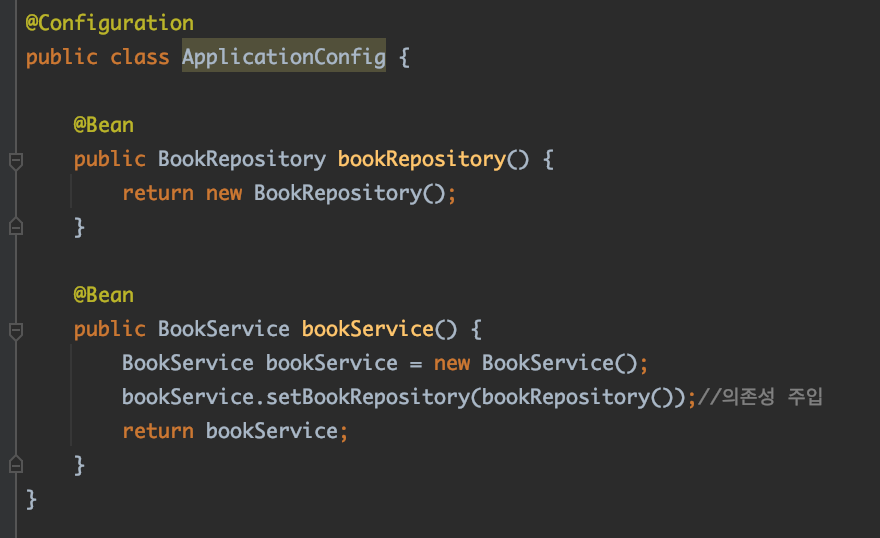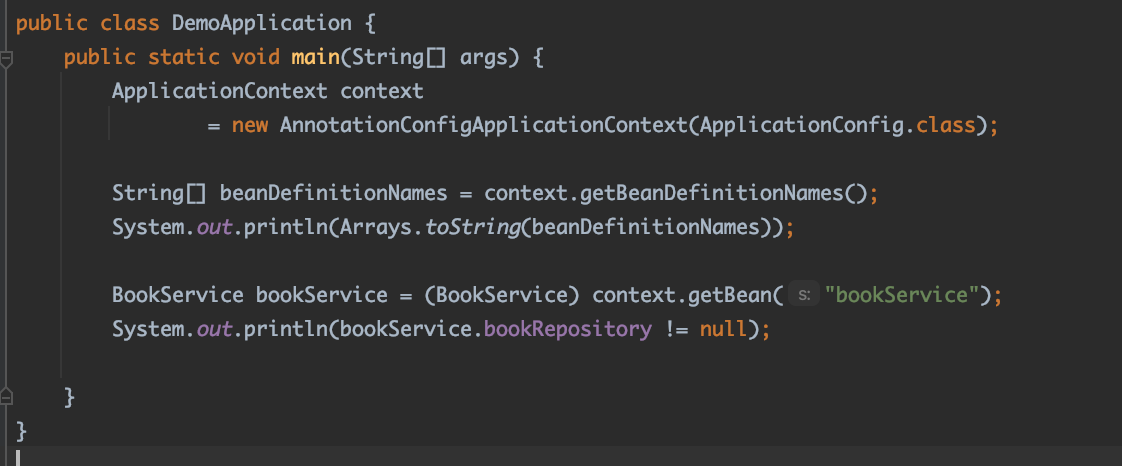스프링 IoC 컨테이너의 역할
- 빈 인스턴스 생성
- 의존관계 설정
- 빈 제공
ApplicationContext
IoC 컨테이너에 있는 ApplicationContext와 BeanFactory(ApplicationContext는 BeanFactory를 상속받는다.) 인터페이스 덕분에 Bean으로 지정한 모든 클래스를 빈으로 등록해주어 다른 클래스에서 의존관계가 필요하다면 이 Bean(스프링 IoC 컨테이너가 관리 하는 객체)으로 등록된 인스턴스들을 전달해주어 의존성 주입(Dependency Injection)이 가능해진다
빈 설정 1 - xml 파일
public class BookRepository {
}
public class BookService {
BookRepository bookRepository;
//setter 주입방식
public void setBookRepository(BookRepository bookRepository) {
this.bookRepository = bookRepository;
}
}public class DemoApplication {
public static void main(String[] args) {
ApplicationContext context
= new ClassPathXmlApplicationContext("application.xml");
String[] beanDefinitionNames = context.getBeanDefinitionNames();
System.out.println(Arrays.toString(beanDefinitionNames));
BookService bookService = (BookService) context.getBean("bookService");
System.out.println(bookService.bookRepository != null);
}
}
빈과 해당 빈에 주입할 빈을 설정해준다.
<?xml version="1.0" encoding="UTF-8"?>
<beans xmlns="http://www.springframework.org/schema/beans"
xmlns:xsi="http://www.w3.org/2001/XMLSchema-instance"
xsi:schemaLocation="http://www.springframework.org/schema/beans http://www.springframework.org/schema/beans/spring-beans.xsd">
<bean id="bookService"
class="com.inflearnspringframeworkbasic.demo.BookService">
<property name="bookRepository" ref="bookRepository"/>
</bean>
<bean id="bookRepository" class="com.inflearnspringframeworkbasic.demo.BookRepository"/>
</beans>일일이 빈 등록해야함.번거롭다
그래서 나온게 component scan으로 빈 등록 , 빈 주입시 @Autowired
빈 설정 2 - component-scan
<context:component-scan base-package="..">으로 base-package에 적어둔 package부터 하위까지 모두 스캔하여 Bean을 등록해준다.
@Component 어노테이션(@Component를 확장한 @Service, @Repository,,도 가능)을 사용한 클래스를 빈으로 모두 자동 등록해준다.
이후 빈을 주입받으려면 @Autowired를 사용한다.
@Repository
public class BookRepository {
}
@Service
public class BookService {
@Autowired
BookRepository bookRepository;
}
<?xml version="1.0" encoding="UTF-8"?>
<beans xmlns="http://www.springframework.org/schema/beans"
xmlns:xsi="http://www.w3.org/2001/XMLSchema-instance"
xmlns:context="http://www.springframework.org/schema/context"
xsi:schemaLocation="http://www.springframework.org/schema/beans http://www.springframework.org/schema/beans/spring-beans.xsd http://www.springframework.org/schema/context https://www.springframework.org/schema/context/spring-context.xsd">
<context:component-scan base-package="com.inflearnspringframeworkbasic.demo"/>
</beans>동일값 출력됨
빈 설정 3 - 자바 설정 파일
@Configuration 가 붙은 클래스를 통해 빈을 모두 등록해준다. 빈을 일일이 등록해야한다.
의존성 주입은 아래의 세가지 방식이 있다.
- 메소드 이름으로 주입해주는 방법
- 파라미터로 받아 주입해주는 방법
- @Autowired를 쓰는 방법


빈 설정 4 - 자바 설정 파일에 ComponentScan
자바 설정파일에 @ComponentScan 어노테이션을 붙여 @Component가 붙은 클래스 혹은 @Compoenent를 확장한 클래스(@Repository,@Service,,)를 모두 빈으로 등록한다.
@Configuration
@ComponentScan(basePackageClasses = DemoApplication.class)
public class ApplicationConfig {
}
@Repository
public class BookRepository {
}
@Service
public class BookService {
@Autowired
BookRepository bookRepository;
public void setBookRepository(BookRepository bookRepository) {
this.bookRepository = bookRepository;
}
}
@SpringBootApplication으로 간단하게 사용가능
빈 설정 5 - SpringBootApplication
configuration과 component scan이 다 속해있기 때문에 @SpringBootApplication어노테이션만으로 @Component 어노테이션이 붙은 빈을 모두 등록가능하다.
